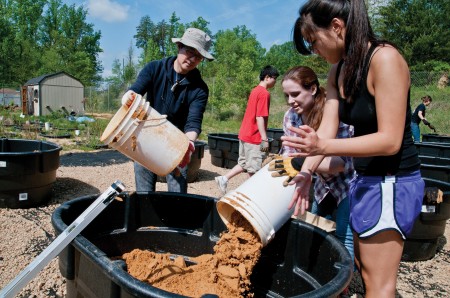Students are helping to develop a model wetland to research the effects of wetland erosion and the benefits of expanding wetland to the Earth’s soil.
Changwoo Ahn, a wetlands ecologist and associate professor with the department of Environmental Science and Policy, developed the Wetland Mesocosm Compound in 2007 with the intent of bringing outdoor environmental study to George Mason University.
“Four years ago, I built [the Wetland Mesocosm Compound] purely with my experience and my idea that the school would need an outdoor teaching and research facility,” Ahn said. “Many big research-oriented schools have this kind of facility, [like] schools that I used to work at before I came to George Mason University, so I had a vision to build this kind of facility before.”
Ahn’s vision for an outdoor research center came to fruition in 2007 with the support of a Sustainability Office grant, the Office of the Provost, ESP, and Long Fence, an area fencing company that donated $20,000 worth of chain link fencing to enclose the compound. The site is located behind Intramural Field I near the West Campus parking lot.
Inside the compound, Ahn and his students are working on developing mesocosms, or medium-sized, contained wetland models.
However, unlike microcosms or Petri dish colonies, mesocosms are in large rubber tubs and are exposed to all the natural elements of the environment, such as sunlight and weather.
One benefit of using mesocosms for research comes from manipulation of water levels in the tubs so that observers can see the effects of rising water levels on a small, contained wetland environment.
According to Ahn, this is important so researchers can better understand how rising water levels affect erosion in coastal wetland environments.
Another important aspect of Ahn’s course is teaching his students how to effectively conduct experiments and gather, graph and interpret the data.
“At the end of this semester, and it’s already drawing to an end, [the students] are actually participating in setting up these new experiments as part of their learning in the semester curriculum in the Ecological Sustainability course,” Ahn said. “In the summertime, we are going to continue to monitor the growing of the plants and the hydration of the mesocosms and all those environmental barriers throughout.”
Ahn sees incorporating undergraduate research as a fundamental aspect of his course. Junior biology major Alex Sessums has been learning about wetland restoration in Ahn’s class all semester and is enthusiastic to be able to help build a model that will aid work in wetland restoration.
“I’ve learned a lot about how research goes down, wetland science and ecology,” Sessums said. “It’s good to get involved and get to work.”
In addition to his work with Mason, Ahn is working with members of surrounding communities to get them more involved with the work that he and his students are doing at the compound.
“I’m trying to reach out to the other communities, not only on campus but off campus, to let them know that we have these facilities,” Ahn said. “This year we’re going to have three high school students doing a small project here over the summer.”
In about three years, after Ahn and his students have completed their experimentation and data collection, their findings will be gathered, analyzed and put in a paper, which will be submitted for publication in a scholarly, peer-reviewed journal.







Comments